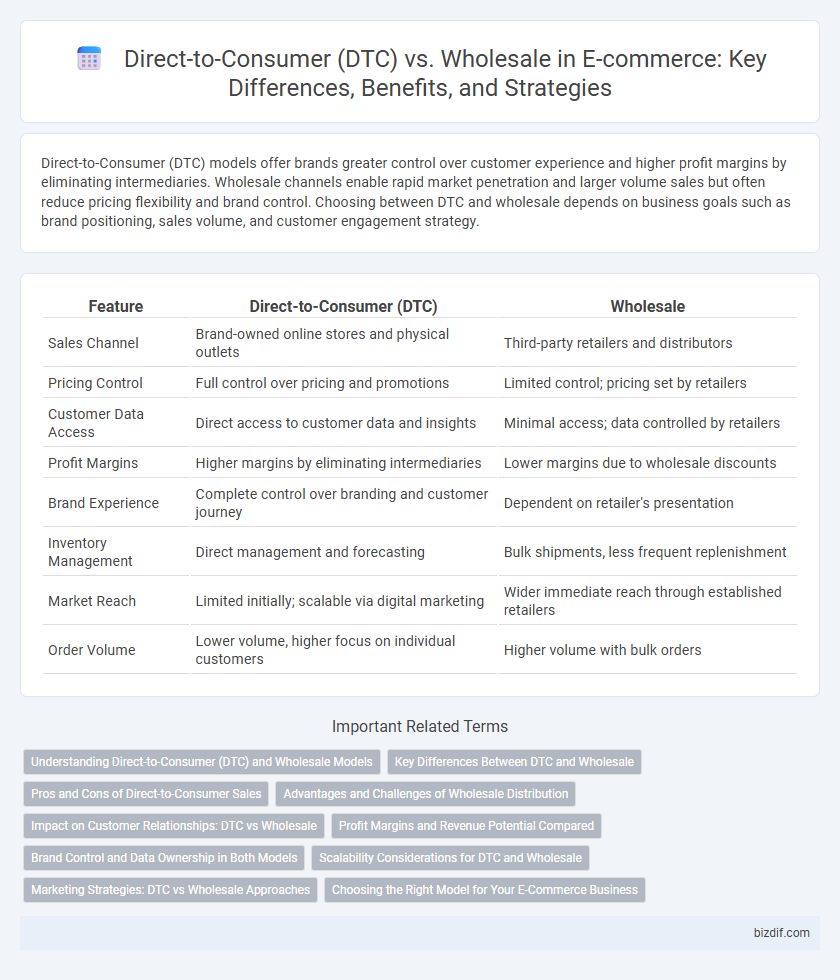Direct-to-Consumer (DTC) models offer brands greater control over customer experience and higher profit margins by eliminating intermediaries. Wholesale channels enable rapid market penetration and larger volume sales but often reduce pricing flexibility and brand control. Choosing between DTC and wholesale depends on business goals such as brand positioning, sales volume, and customer engagement strategy.
Table of Comparison
| Feature | Direct-to-Consumer (DTC) | Wholesale |
|---|---|---|
| Sales Channel | Brand-owned online stores and physical outlets | Third-party retailers and distributors |
| Pricing Control | Full control over pricing and promotions | Limited control; pricing set by retailers |
| Customer Data Access | Direct access to customer data and insights | Minimal access; data controlled by retailers |
| Profit Margins | Higher margins by eliminating intermediaries | Lower margins due to wholesale discounts |
| Brand Experience | Complete control over branding and customer journey | Dependent on retailer's presentation |
| Inventory Management | Direct management and forecasting | Bulk shipments, less frequent replenishment |
| Market Reach | Limited initially; scalable via digital marketing | Wider immediate reach through established retailers |
| Order Volume | Lower volume, higher focus on individual customers | Higher volume with bulk orders |
Understanding Direct-to-Consumer (DTC) and Wholesale Models
Direct-to-Consumer (DTC) models enable brands to sell products directly to customers through online platforms, allowing greater control over pricing, branding, and customer engagement. Wholesale models involve selling products in bulk to retailers or distributors, which then resell to end consumers, often resulting in lower margins but broader market reach. Understanding these models helps businesses optimize supply chains, marketing strategies, and profit margins in the competitive e-commerce landscape.
Key Differences Between DTC and Wholesale
Direct-to-Consumer (DTC) involves brands selling products directly to customers through online platforms, offering higher profit margins and greater control over customer experience. Wholesale requires brands to sell in bulk to retailers, which then handle distribution and sales, often resulting in lower margins but wider market reach. Key differences include pricing strategies, control over branding, customer data access, and the complexity of supply chain management.
Pros and Cons of Direct-to-Consumer Sales
Direct-to-Consumer (DTC) sales offer brands higher profit margins by eliminating intermediaries, enabling direct customer engagement and personalized marketing. Challenges include the need for robust logistics, customer service infrastructure, and upfront investment in digital platforms. Compared to wholesale, DTC allows better brand control but requires significant resources to scale and manage end-to-end customer experience.
Advantages and Challenges of Wholesale Distribution
Wholesale distribution in e-commerce offers the advantage of rapid market expansion through established retail partnerships, enabling brands to reach broader audiences with reduced marketing costs. However, challenges include lower profit margins due to bulk discount pricing and limited control over brand presentation and customer experience. Managing inventory levels and navigating complex supply chain logistics also require significant resources and coordination.
Impact on Customer Relationships: DTC vs Wholesale
Direct-to-Consumer (DTC) channels foster stronger customer relationships by enabling personalized interactions, direct feedback, and tailored marketing strategies that enhance brand loyalty. Wholesale models prioritize volume sales through third-party retailers, limiting direct engagement and reducing opportunities for brands to gather consumer insights. Consequently, DTC approaches provide richer data on customer behavior, facilitating optimized product offerings and improved customer experience.
Profit Margins and Revenue Potential Compared
Direct-to-Consumer (DTC) models typically achieve higher profit margins by eliminating intermediaries, allowing brands to retain full retail markup and control over pricing strategies. Wholesale channels often generate lower margins due to distributor discounts, but they can drive significant revenue volumes through expanded market reach and bulk sales. Balancing these approaches enables companies to optimize overall profitability by leveraging DTC's margin advantages alongside wholesale's scale-driven revenue potential.
Brand Control and Data Ownership in Both Models
Direct-to-Consumer (DTC) models offer brands full control over customer experience, pricing, and marketing strategies while enabling direct access to valuable consumer data for personalized targeting and product innovation. Wholesale models often limit brand control as intermediaries influence retail presentation and pricing, causing fragmented data ownership that restricts insights into end-customer behavior. Ownership of customer data in DTC channels enhances long-term brand loyalty and facilitates agile decision-making, contrasting sharply with the limited data visibility inherent in wholesale distribution.
Scalability Considerations for DTC and Wholesale
Direct-to-Consumer (DTC) models offer greater control over branding and customer relationships but require significant investments in marketing, fulfillment infrastructure, and customer service to scale effectively. Wholesale partnerships enable rapid distribution expansion through established retail networks, yet profit margins tend to be lower and brand control limited. Scalability in DTC hinges on robust e-commerce platforms and logistics capabilities, while wholesale scalability relies on broad retailer adoption and consistent product supply.
Marketing Strategies: DTC vs Wholesale Approaches
Direct-to-Consumer (DTC) marketing strategies emphasize personalized customer engagement through social media ads, influencer partnerships, and targeted email campaigns, driving brand loyalty and higher profit margins. Wholesale approaches rely on building relationships with retailers and leveraging their established distribution channels and in-store promotions to expand market reach quickly. DTC brands benefit from data-driven insights for tailored messaging, while wholesale focuses on bulk sales and broad market penetration through partner networks.
Choosing the Right Model for Your E-Commerce Business
Selecting the right model between Direct-to-Consumer (DTC) and Wholesale depends on factors such as profit margins, brand control, and customer relationship management. DTC offers higher margins and direct access to customer data, enhancing personalized marketing and brand loyalty, while Wholesale provides broader distribution and scalability but often with lower margins and less brand control. Analyzing your target market, operational capacity, and long-term growth strategy will guide optimal e-commerce business model selection.
Direct-to-Consumer (DTC) vs Wholesale Infographic

 bizdif.com
bizdif.com